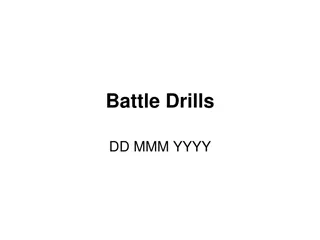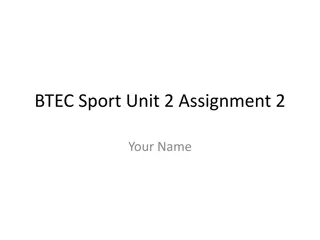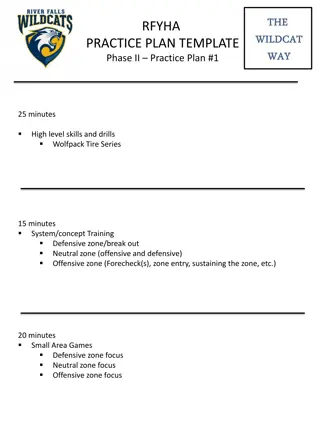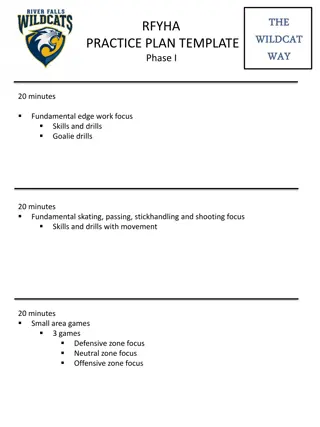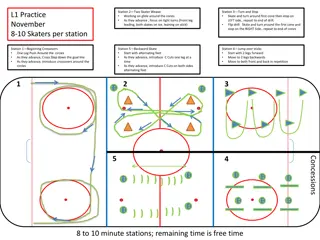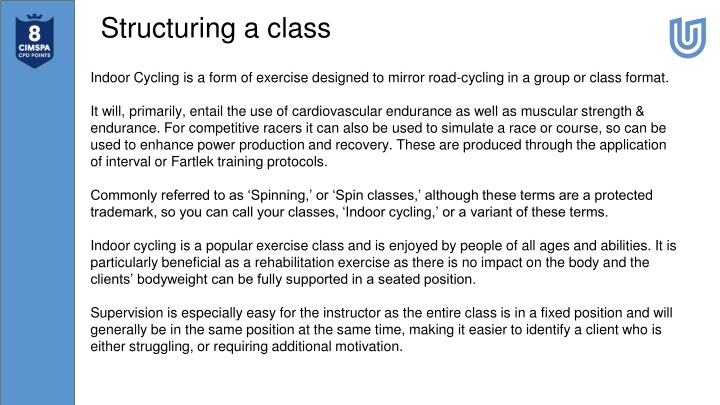
Class Structure & Drills for Indoor Cycling Workouts
"Discover the essence of structuring an engaging Indoor Cycling class, covering choreographed, timed, and interactive drills. Learn how to design effective sessions for a diverse range of participants and explore the benefits of this popular group exercise. Enhance your knowledge of cardiovascular endurance, muscular strength, and interval training while creating a dynamic and motivating environment in your indoor cycling classes."
Download Presentation

Please find below an Image/Link to download the presentation.
The content on the website is provided AS IS for your information and personal use only. It may not be sold, licensed, or shared on other websites without obtaining consent from the author. If you encounter any issues during the download, it is possible that the publisher has removed the file from their server.
You are allowed to download the files provided on this website for personal or commercial use, subject to the condition that they are used lawfully. All files are the property of their respective owners.
The content on the website is provided AS IS for your information and personal use only. It may not be sold, licensed, or shared on other websites without obtaining consent from the author.
E N D
Presentation Transcript
Structuring a class Indoor Cycling is a form of exercise designed to mirror road-cycling in a group or class format. It will, primarily, entail the use of cardiovascular endurance as well as muscular strength & endurance. For competitive racers it can also be used to simulate a race or course, so can be used to enhance power production and recovery. These are produced through the application of interval or Fartlek training protocols. Commonly referred to as Spinning, or Spin classes, although these terms are a protected trademark, so you can call your classes, Indoor cycling, or a variant of these terms. Indoor cycling is a popular exercise class and is enjoyed by people of all ages and abilities. It is particularly beneficial as a rehabilitation exercise as there is no impact on the body and the clients bodyweight can be fully supported in a seated position. Supervision is especially easy for the instructor as the entire class is in a fixed position and will generally be in the same position at the same time, making it easier to identify a client who is either struggling, or requiring additional motivation.
Structuring a class Broadly speaking, there are 3 main types of drills you can use in an indoor cycling class. 1. Choreographed Drills: A drill inspired by a song. This type Of drill will use a variety of cycling positions to match the tempo of the song without using a timer to transition in and out of cycling positions. The benefit of this style of drill is to inspire people to move with the music and work within the intensity of the song. You do not need to be a choreographer to teach this style of drill, you simply need to practice cueing with the drill as it is already laid out for you. As you progress into creating your own choreographed drills, always remember to keep the BPM (beats per minute) within reason of the RPM (revolutions per minute) as some speeds in a song are too fast for safe riding.
Structuring a class Broadly speaking, there are 3 main types of drills you can use in an indoor cycling class. 2. Timed Drills: A drill inspired through the use of a timer. There are numerous apps you can use, for example the app called Tabata Pro Timer" has everything you need in a time for cycling classes. By using a timer, you can transition in and out of cycling positions while working on specific training variables such as speed, endurance, power, and strength. Your riders know exactly how much time they have so they can choose how hard to push on each interval.
Structuring a class Broadly speaking, there are 3 main types of drills you can use in an indoor cycling class. 2. Interactive Drills: A drill inspired by the interaction of participants creating a fun environment for fitness. This type of drill is often coined as games" however, never allow the word games to fool you into thinking games are not a good workout. The interactive component of this style of drill engages participants to push their intensity with each other. Research has shown time and time again that the more interactive and fun a group fitness program is, the greater the cohesion amongst participants which increases class participation significantly. Remember, adults like to have fun too!
Structuring a class As with every other group fit class or activity, the structure of a session remains the same; 1. Progressive CV warm-up: This is vital in every class, and should take between 3-5 minutes. This is your opportunity to adjust clients posture, bike setup, riding position etc. before you progress to more challenging activity, where improper form can be of greater risk. Main body of work: Here s where you make the class work as hard as each one can. Try to instill a bit of competition but not to the point that you have an unconditioned beginner trying to keep pace with a seasoned road-racer. Your class will be made up of all the various hand and body positions we ve mentioned in the other unit, as well as different cadences and drills. A word of caution, don t throw the kitchen sink at them. Keep it simple to begin with. CV cool-down: Taper off the intensity until you bring them back to the pre-workout intensity. This should be about 5-6 minutes and you can incorporate some static stretches for the upper body on the bike. Static stretches: Off the bike stretches for the lower limbs. Feedback & class information for future classes. Also use this opportunity to check for injuries and client welfare. 2. 3. 4. 5.

